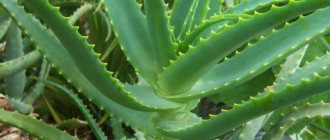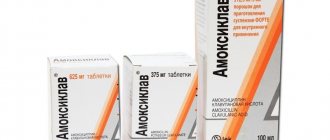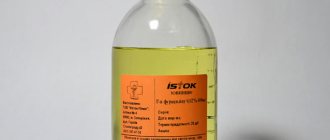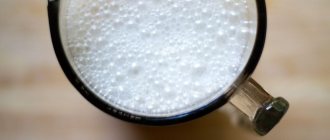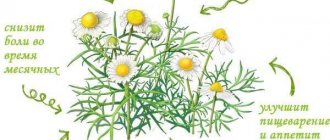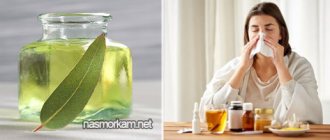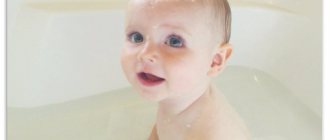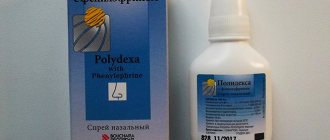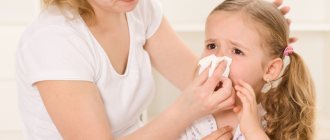Naphthyzine and saline solution for inhalation treatment for a child
Many parents use the well-known drug Naphthyzin for nasal congestion in children. Thanks to the main active ingredient naphazoline, the medicine quickly eliminates swelling, reduces nasal secretion and makes breathing easier. In some cases, doctors may prescribe naphthyzine inhalations to children, but the medicine must first be diluted with saline; it is not used in its pure form. The procedures significantly alleviate the course of the disease and speed up recovery; in addition, inhalation therapy can be prescribed as a preventative measure.
The greatest effectiveness of the procedure is achieved by carrying it out through a nebulizer. However, it should be remembered that an overdose of naphthyzine is dangerous for children, so parents should strictly observe the proportions and use the drug only as prescribed by a doctor.
Inhalation through a nebulizer for a runny nose and cough
For a runny nose (rhinitis and sinusitis), inhalations are performed with a suspended particle size of 10 microns or more. Or in special models of nebulizers for the treatment of sinusitis.
- Vasoconstrictor drugs: naphthyzine, xylometazoline relieve swelling from the mucous membrane of the nose and sinuses, temporarily facilitating nasal breathing. Most effective in the first days for nasal congestion. Most often, they are used in the form of drops or a spray for a runny nose. In children under 1 year of age, they are not used as inhalations. The concentration of drugs is no more than 0.01% for children from 1 to 2 years old, 0.025% for children up to 7 years old, 0.05% for children up to 12 years old. 4-5 drops of the drug of the required concentration are diluted in 2-3 ml of saline solution. Inhalations can be repeated 2 times a day. The maximum duration of treatment is 5-7 days.
- Isofra is an antibiotic that is most often used in the form of a spray, not from the first days of illness, but in the case of prolonged rhinitis or rhinosinusitis (when a secondary infection is attached). In inhalation through a nebulizer, the drug will be even more effective if the conditions stated above are followed. Can be used in children from birth. For one inhalation, 1 spray of spray is used in a container with 2-3 ml of saline solution. Inhalations are carried out 2-3 times a day, the maximum duration of treatment is 7 days.
- Polydexa - combines several drugs: a vasoconstrictor, a hormonal drug (dexamethasone) and 2 antibiotics. Allowed for children from 2.5 years old. The dosage and recommendations are the same as for isofra.
- Bioparox is a local antibiotic. Used in children from 2.5 years of age. The dose and recommendations are the same. Maximum course of treatment 7 days
- Rinofluimucil is a combined drug: a vasoconstrictor that thins mucus and promotes its removal and restores the mucous membrane. It is used for prolonged rhinitis and rhinosinusitis (not from the first days of illness). It is widely used in children from 3 years of age, and very rarely before 3 years of age. Most often used in the form of a spray. Dosage and recommendations for inhalations, as for isofra.
Indications for use
The drug is prescribed to children mainly for severe nasal congestion, when other safer remedies are powerless. In such cases, it is used as a means for topical use, instilling 1-2 drops 2-3 times a day.
Indications for the use of inhalation therapy with naphthyzine for children may include obstructive bronchitis, laryngitis, pharyngitis, tracheitis and other diseases of the lower and upper respiratory tract.
The drug has proven itself in the treatment of false croup, which is accompanied by stenosis (swelling of the soft tissues of the larynx) and a dry barking cough. After the first inhalation, the symptoms are smoothed out and disappear completely over time.
Once again, I would like to note that for greater effectiveness, inhalation with naphthyzine is best done using a nebulizer.
Benefits of inhalation therapy
When choosing a method of treating children, many parents prefer inhalations - this is a harmless, painless and effective way to get rid of the disease.
Unlike tablets, which travel a long way through the gastrointestinal tract before taking effect and partially lose their potency, medicine delivered by inhalation acts directly on the problem, and in a matter of minutes it envelops and is absorbed into the lesion.
There is nothing to say about injections for children, this is the worst thing that can happen. But local nasal medications have a limited effect and often flow out of the nasal cavity without having any effect. The best alternative to such treatment is inhalation, especially if the procedure is carried out through a nebulizer.
The nebulizer inhaler converts the medicinal liquid into many fine aerosol particles (it does not evaporate, but sprays them), which, with inhalation, go directly to the lesion, penetrating into the most inaccessible places, while the medicine does not lose its effectiveness.
Due to the fact that the drug is absorbed specifically into the affected area, a quick and most effective therapeutic effect is achieved. Another advantage of inhalation through a nebulizer is that the medicine has a local effect, bypassing the blood, and does not affect the body as a whole, as often happens with oral or injection treatment.
Using a nebulizer, treatment can be carried out even for children of the first year of life by installing the device near the crib (spraying will be carried out into the air). In the same way, a nebulizer is used to treat bedridden patients.
Which inhaler to choose
When choosing an inhaler, attention should be paid to the size of the particles sprayed by the device, since this affects their ability to penetrate the respiratory tract (each nebulizer has an annotation that contains all the information about this).
There are devices that have a regulator for the size of sprayed particles - this is a compressor nebulizer (for example, “Dolphin”), it is suitable for treating both the upper and lower respiratory tract, working in several modes. This is a universal device that has no restrictions on the use of medicines. A compressor-type nebulizer is ideal for inhalation using naphthyzine; its only drawback is its noisy operation.
Before using naphthyzine for inhalation treatment of children, you should consult a doctor and know the exact dosage of the drug, this will help prevent side effects and the development of complications in children.
Treatment of nasal congestion in adults: recipes for an inhaler
What to put in a nebulizer for treating adults? Inhalations using a nebulizer can be carried out using a variety of solutions. The simplest are saline solution, mineral and sea water. Those medicines that have a more complex composition are prepared on their basis. But they should be used only on the recommendation of the attending physician. So, what can you fill in?
Miramistin
Inhalations using Mirastimin can quickly and effectively eliminate a runny nose, which is characterized by purulent discharge. An adult can use a pharmaceutical 0.01% solution in ready-made form. It is sent to the nebulizer in an amount of 4 ml. It is necessary to carry out therapeutic manipulation 3 times a day. Read how to use Miramistin for a runny nose here.
The drug is also used to rinse the nose.
Interferon
A runny nose caused by a virus can be overcome with inhalations of Interferon. It is very simple to obtain a medicinal solution. You need to bring the saline solution to a temperature of 37 degrees, and then send 3 ampoules of Interferon into it. Place the resulting composition in a nebulizer to a volume of 4-5 ml. Inhalations must be carried out 2 times a day.
Tonsilgona
The drug Tonsilgon is excellent. This drug is of natural origin. It perfectly eliminates bacteria that caused a runny nose. Tonsilgona also has an anti-inflammatory and antimicrobial effect. To prepare the solution, you need to combine Tonsilgon and saline solution in equal quantities. Perform inhalations 3 times a day. Be sure to read the composition of Tonsilgon before use.
With calendula
Very often, natural ingredients are used to obtain a medicinal solution. To obtain this composition, you need to purchase calendula tincture, which is available at any pharmacy. Take one part of it and combine it with 40 parts of saline solution. Carry out inhalations 3 times a day.
This medicine is considered universal, as it can overcome a wide variety of types of rhinitis.
Alkaline
Medicinal mineral water can be used as an alkaline solution for inhalation with a nebulizer. As a rule, when fighting a runny nose, it is worth using Borjomi water. It has a mild effect and a safe effect on the patient’s health. With this treatment, it is possible to thin sputum and purulent discharge in the throat and nose in a short period of time. Use inhalations based on mineral water 6 times a day.
Eucalyptus
To prepare the solution, you can use eucalyptus leaves or its oil. It can be used not only in a nebulizer. To do this, simply inhale the vapors over the bowl and cover yourself with a towel. But you won’t be able to get such a quick effect as when using a nebulizer. In addition, this procedure will become much simpler and easier. To obtain the medicinal composition, you need to take finely chopped eucalyptus leaves (2 tablespoons), 1 liter of clean water. Place the container with the mixture on the stove and bring to a boil. Wait until the solution reaches room temperature and pour it into the nebulizer. Carry out treatment 2 times a day.
Thanks to the eucalyptus solution, it is possible to quickly cope with rhinitis and nasal congestion.
Preparing the solution
Naphthyzine is not used in pure form for inhalation treatment in children; before use, it should be diluted with saline solution.
If you use naphthyzine 0.05% for children, it should be diluted with saline solution, the dosage in this case is 1:5 (1 ml of naphthyzine per 5 ml of saline). If you have a drug with a concentration of 0.1% in your medicine cabinet, then before giving inhalations to children, dilute it in a ratio of 1:10 (1 ml of naphthyzine per 10 ml of saline solution).
Preference is given to sterile saline solution, which is sold at every pharmacy kiosk. However, if you don’t have time to go to the pharmacy, you can make it yourself - 1 tsp. Thoroughly dissolve the salts in 1 liter of boiled water. The duration of storage of such a solution should not exceed 24 hours.
How to use correctly
To achieve the desired effect in treating the disease, you need to know how to properly inhale a child with Naphthyzin. In the pharmacy you can find a solution of this drug in several concentrations. A 0.05% solution is used to treat children, and 0.1% is used to treat children over 6 years of age and adults.
The medicine is not used in its pure form; it must be diluted with saline in a one to one ratio. It is very important to maintain the correct dosage of Naphthyzin for inhalation, as this measure will help avoid the development of dangerous complications.
Sterile saline solution is best purchased at a pharmacy, but you can also prepare it yourself.
To do this, you need to dissolve two teaspoons of iodized salt in a liter of boiled water. This solution is stored in the refrigerator for about a day.
The prepared mixture for inhalation must be poured into the inhaler and the procedure must begin. The duration of inhalation varies depending on the age of the patient. Children under 6 years old – no more than 2 minutes; over 6 and adults – 3-5 minutes. The recommended number of procedures is 3-4 per day.
Modern inhalers allow you to regulate the temperature of the medicinal solution. So, for children under 3 years old it should not be more than 30°C, from 3 to 6 years old - no more than 40°C, for children over 6 years old and adults up to 55°C.
To treat pathologies of the upper respiratory tract, it is recommended to use steam inhalers, and for the lower respiratory tract - special nebulizers that help spray the solution into the right place.
If the drug is used incorrectly, dangerous complications can develop, so you must strictly follow the dosage and instructions for use.
Carrying out the procedure
When using a steam inhaler, you should take into account the fact that this procedure is effective only for treating the upper respiratory tract; steam does not penetrate into the lower sections.
Steam inhalations for children under 6 years of age can be performed no more than three times a day, the duration of each procedure is 3 to a maximum of 5 minutes. The amount of the finished solution (naphthyzine + saline solution) is 3 ml. The temperature of the medicine should not exceed 40°C for children under 5 years of age and 52°C for older children.
In addition, parents should know that steam inhalations should not be performed during the first 2-3 days after the onset of the disease. Also, inhalation treatment is prohibited at elevated body temperature, even if it is low-grade (37.2°C).
To treat the lower respiratory tract, it is recommended to use nebulizers. The amount of the finished solution is also 3 ml. Duration of 1 procedure is 5-10 minutes for a course of 5-10 days. To relieve stenosis (swelling of the larynx) with false croup, one procedure is sufficient; if necessary and with prior agreement with the doctor, the manipulation can be repeated. Inhalations with a nebulizer are not recommended at elevated body temperatures.
Inhalation for cough Nebulizer for runny nose and cough
Acute laryngotracheitis with laryngeal stenosis and acute attack of bronchial obstruction first aid
- All drugs can be used from the moment the first symptoms of stenosis or obstruction appear
- The aerosol particle size should be about 5 microns for laryngitis and 2-5 microns for bronchitis.
- You can start inhalations with soda or sodium chloride on your own.
- Other medications can only be used as prescribed by a doctor, because there is a danger of side effects and overdose.
Naphthyzin
Naphthyzin is used in inhalation through a nebulizer for laryngeal stenosis only in Russia. Such treatment is carried out only in a hospital under the supervision of doctors, because in this case, naphthyzine is used in a larger dose than for the treatment of a runny nose, so overdose symptoms very often occur. It is not used for bronchitis and asthma in children.
Berodual
Berodual is not a hormonal drug. It is most often prescribed to children by pediatricians to relieve lagingospasm and bronchial obstruction at home and in the hospital. But the drug has side effects: rapid heartbeat, tremors (shaking hands), increased blood pressure, etc. Therefore, the dose for each child is selected individually by the doctor (up to 6 years, no more than 10 drops per dose, no more than 30 drops per day, 6 -12 years 10-20 drops and 30-60 drops, respectively, treatment begins with small doses, in severe cases the dose can be increased). The required dose of Berodual is diluted in the volume of saline solution required for one inhalation.
Cautions
It is necessary to strictly adhere to the recommended dosage, number of procedures and time of their implementation.
Failure to comply with the rules for the use of naphthyzine can provoke a number of side effects:
- children may experience a sharp deterioration in their health;
- apathy, lethargy, drowsiness appear;
- dizziness and nausea;
- paleness of the skin;
- cold sweat;
- stomach ache.
Use the drug exclusively for its intended purpose and only after prior consultation with your doctor.
Possible side effects
A negative reaction from the body occurs as a result of an overdose. The patient experiences:
- abdominal pain;
- loss of energy throughout the day;
- feels unrested in the morning;
- vomiting and nausea;
- aversion to food, even to your favorite dishes;
- cold sweat;
- bradycardia.
Deterioration in well-being becomes noticeable on the skin. They turn pale or blue. Such manifestations are rarely noticeable in people whose bodies cannot tolerate certain components of the solution. In other cases, the people themselves are to blame for not adhering to the proportions recommended by the attending physician. It is forbidden to prepare the solution in advance; it is better to dilute the liquid before the procedure itself.
The recommended treatment period is from 5 to 7 days. If therapy is extended for a few more days, it may become addictive. Therefore, to get a positive effect, it is better to trust your doctor.
Brief overview of the drug
Naphthyzin is an anticongestive drug. Its main effect is vasoconstrictor. Once on the mucous membrane, the drug affects adrenergic receptors and stimulates. As a result, adrenaline production increases. Biologically active substances narrow the lumen of small blood vessels. This mechanism of action leads to a reduction in swelling of the mucous membrane.
Under the influence of Naphthyzin, inflammation and hyperemia of the epithelium are reduced, nasal breathing is restored, increased production of exudate is stopped, and the symptoms of a runny nose disappear.
The main active ingredient is naphazoline (anticongestant). Auxiliary component is boric acid. It is an antiseptic and has a disinfecting effect.
In appearance, Naphthyzin is a transparent solution for topical use, without impurities, inclusions or sediment. Available in glass or plastic bottles of 10, 15 and 20 ml.
Description of the drug
"Naphthyzin" is a transparent solution designed for topical use. There are no special impurities in its composition, and there is no sediment. Release form: bottle made of glass. On sale you can find a bottle with the following volume:
It has one important effect - the ability to constrict blood vessels. With the help of the components in the composition, the width of the vessels is reduced. The solution is based on naphazoline, the additional substance is boric acid. Disinfects areas of the mucous membrane, as it is an antiseptic.
For what diseases are inhalations indicated for children?
Inhalations with Naphthyzin in pediatric practice are prescribed for infectious and inflammatory processes of the respiratory system.
The drug is indicated for the following diseases:
- rhinitis and sinusitis;
- complicated ARVI and influenza;
- acute laryngitis;
- infectious pharyngitis;
- acute tracheitis;
- obstructive bronchitis - spasm of the bronchi with blockage of sputum discharge.
Naphthyzine for inhalation is not used for children of the first year of life.
After the procedure, the severity of cold symptoms decreases, some of them stop. Symptoms of diseases that disappear after inhalation of the drug:
- nasal congestion;
- itching, irritation of mucous membranes, sore throat;
- swelling of the upper respiratory tract;
- pain in the larynx when talking;
- discomfort in the throat while eating;
- suffocating cough;
- redness of the nasopharynx.
Inhalations with Naphthyzin for laryngitis prevent the risk of developing false croup at night - a sharp spasm of the glottis, which is accompanied by an attack of suffocation and breath holding. After the procedure, a child with childhood laryngitis has a barking cough, noisy breathing, and inspiratory shortness of breath.
Naphthyzin is not prescribed for chronic processes in the respiratory organs, year-round allergies or hay fever.
Inhalations for children with naphthyzine, rules of conduct
For ARVI, the pediatrician may prescribe inhalation for children with Naphthyzin.
This therapy eliminates swelling, making breathing easier. Sometimes inhalation therapy is carried out using Naphthyzin with saline solution. Treatment speeds up the healing process.
Modern pediatricians advise inhalation through a nebulizer. In this case, it is necessary to comply with the prescribed dosage.
The medication in question is indicated for use for the following diseases:
- rhinitis;
- sinusitis;
- complicated course of ARVI and influenza;
- ENT pathology;
- obstructive form of bronchitis.
Inhalations with Naphthyzin are recommended after studying the instructions for use. The active substance of the drug is naphazoline.
It is classified as a local vasoconstrictor decongestant.
To improve the child’s well-being by facilitating his nasal breathing, you will need to wait 5-6 hours after inhalation therapy.
To achieve a good vasoconstrictor effect, it is recommended to give children Naphthyzin with sodium chloride. The disadvantage of this therapy is the short-term effect. It is prescribed for infectious and inflammatory processes occurring in the respiratory organs.
The use of naphthyzine is contraindicated for infants
Naphthyzine for inhalation is contraindicated in infants. After each manipulation, the severity of the clinical picture of the disease decreases, including:
- stuffy nose;
- itching;
- discomfort in the throat;
- swelling of the upper respiratory tract;
- pain in the larynx.
Using the procedures under consideration, it is possible to prevent the development of false croup if the child suffers from laryngitis.
At the same time, a spasm of the gap is prevented, in which suffocation is observed and breathing is held. After inhalation, a barking cough and noisy breathing appear.
Naphthyzin is contraindicated in case of a chronic process occurring in the respiratory system or persistent allergies.
Inhalation is considered a harmless, painless and effective method for treating respiratory diseases. Tablets, unlike inhalation solutions, act after passing a long way through the gastrointestinal tract. In this case, their strength is partially lost.
Inhalations with Naphthyzin affect the disease, quickly enveloping and absorbing into the lesion. Injections, unlike inhalation solutions, cause fear. Such therapy has a negative effect on the child’s psyche.
The advantage of the therapy under consideration is the provision of local effects. Inhalations do not affect the composition of the blood and the body as a whole. It is allowed to use a nebulizer for children of the first year of life. In this case, it is recommended to install the device near the crib. It will spray the drug into the air.
Inhalation is a therapeutic, painless procedure
If a child has been prescribed Naphthyzin for inhalation, it is recommended to consult a pediatrician about choosing an inhaler.
Experts advise paying attention to the size of the particles sprayed by the device. This affects their ability to penetrate the respiratory system.
This information is indicated in the instructions for the inhaler.
Compressor devices are equipped with a regulator for the size of sprayed particles. They are used to eliminate the symptoms of diseases occurring in the lower and upper respiratory tract.
Compressor nebulizers are considered universal devices that have no restrictions on the use of drugs. Such units are used for inhalation therapy with Naphthyzin. Their disadvantage is noisy operation.
Preparing the solution
Inhalation therapy with Naphthyzine is carried out after diluting the drug with saline solution.
If Naphthyzin 0.05% is used for a child, it is diluted with saline in a ratio of 1:5.
Pediatricians advise using sterile saline solution. For self-cooking you will need 1 tsp. salt and 1 liter of water. This solution can be stored for a day.
Inhalation therapy for children under 6 years of age is carried out three times a day, 2 minutes for each session. For older children, a similar number of inhalations per day is indicated, but their duration is 5 minutes.
The temperature in the inhaler is set taking into account the child’s age:
- Up to 3 years - 30°C.
- 3-4 years - 40°C.
- Over 5 years - 52°C.
The duration of therapy depends on the diagnosis. On average, treatment lasts up to 10 days. If the disease is detected at an early stage, the child may be prescribed up to 2 procedures. If swelling is detected, a one-time inhalation is indicated.
Cautions
At high temperatures, inhalation is contraindicated
If the dosage of the medication during therapy was violated or the duration of inhalation exceeded a week, the child is more likely to experience the following adverse reactions:
- severe irritation of the nasal mucosa;
- lack of blood supply to tissues;
- a medicinal form of rhinitis provoked by long-term use of the drug;
- an atrophic form of rhinitis, in which the mucous membrane degenerates.
If the proportions of the solution for inhalation therapy are violated, the functioning of the internal organs of the child may be disrupted:
- vomit;
- regurgitation;
- migraine;
- fever;
- convulsions;
- increase in blood pressure.
Inhalations are not carried out at high body temperatures. Other contraindications to the manipulation in question:
- bacterial infection in which purulent exudate is present;
- bleeding in the respiratory system;
- heart disease;
- DN.
The manipulation in question is effective and aimed at quickly eliminating cold symptoms. If you follow all the pediatrician's recommendations, you can minimize the risk of side effects.
Preparation of the solution and rules for its use
The drug in its pure form is not used as an aerosol. The medicine is diluted with physiological NaCl solution 0.9%. Depending on the concentration of Naphthyzin, the liquid is diluted in the following ratios:
The components of the mixture must be sterile. First, the required amount of saline solution is measured, and then Naphthyzin is added to it. The liquid for inhalation is prepared for children immediately before use. The dosage of the drug is determined by the attending physician in each individual case.
The use of an inhaler provides for the effect of the drug only on the upper respiratory tract.
The size of dispersed particles does not allow the medicine to penetrate into the bronchial tree and lungs.
Depending on the diagnosis, children are given from 1 to 3 inhalations per day. The last procedure can be performed before bedtime so that the drug acts on the mucous membranes for as long as possible and ensures a restful sleep.
What solutions are there?
The classification of drugs for inhalation allows doctors to select the necessary drug in accordance with the clinical picture of the disease in children and adults.
Inhalations for active inflammation in any respiratory diseases are aimed at eliminating the inflammatory process, reducing and eliminating the pathogenic activity of bacterial microflora. Among the effective means are:
- Rotokan (2 ml of solution per 1 ml of saline);
- Malavit (1 ml of solution per 1 ml of saline);
- Tonsilgon N (2.5 ml of medicine per 2 ml of saline solution).
All preparations have a herbal base, which helps relieve swelling of the pharynx, larynx and bronchi, and have a beneficial effect on local immunity. Herbal medicine is a safe treatment method, but can cause side effects such as allergic reactions, rashes, and increased coughing. It is important to stop the drug and consult a doctor.
Alcohol tinctures of propolis, calendula (for children over 7 years old), oil inhalations with eucalyptus, tea tree oil (for children over 12 years old) can help as herbal medicine.
With a runny nose
Solutions should be diluted taking into account age dosage. For a runny nose, the drugs Zvezdochka, Rotokan, and Pinosol are effective. For children over 7 years old, oil inhalation is acceptable. To prepare, you need to dilute fir or eucalyptus oil with saline solution (in a ratio of 0.2 l per 15 drops of oil). Solutions of Chlorhexidine, Miramistin, Furacilin, and Sodium chloride are suitable for newborn babies. For a runny nose, 2 procedures per day are enough.
Antiseptics do an excellent job of combating the activity of pathogenic microflora and eliminating inflammation. They are used as inhalations for sinusitis, sinusitis, and laryngitis. The following medicinal compositions are used:
- Antibiotic Fluimucil (1-2 ml of solution diluted with saline solution, used 2-3 times a day);
- Furacilin (1 tablet per 100 ml of saline solution, 2-3 times a day);
- Dioxidin (4 ml of solution per 2 ml of saline, 4 times a day);
- Gentamicin (1 ml of medicinal composition per 5 ml of saline solution several times a day);
- Miramistin (4 ml of aqueous solution 4 times a day).
The drug Chlorophyllipt, based on eucalyptus leaves, is effective for staphylococcal infections of the respiratory system. All dosages are conditional; it is important to understand that in pediatric practice, every step must be agreed with a doctor.
Medicinal solutions for inhalation are intended to strengthen local immunity. The drugs can speed up the patient’s recovery and reduce the intensity of symptoms. Popular remedies for children are:
- Interferon. Powder for the preparation of nasal drops. 1 inhalation procedure requires 2 ml of the drug. Procedures are carried out 2-3 times a day.
- Derinat drops. The main component is sodium deoxyribonucleate. Suitable for the treatment of ARVI. 1 inhalation procedure requires a prepared solution in the ratio of 2 ml of medication per 2 ml of saline solution.
At the same time, immunomodulators can be taken in the form of rectal suppositories, tablets or ointments. To do this, you can lubricate the nasal passages with antiviral liniments, which increase the strength of local immunity. The effectiveness of drugs against bronchial asthma and allergic rhinitis is practically unconfirmed.
Vasoconstrictors are the main therapy for nasal and laryngeal congestion. Swelling of the mucous membranes of the nasal passages and pharynx accompanies almost every disease of the respiratory system and ENT organs. Commonly used means are:
- Epinephrine or Adrenaline. Suitable for life-threatening edema of the larynx, tracheal tract, croup, as well as for chronic laryngitis and bronchitis. Use with caution in case of arrhythmia, tachycardia. Approximate dosage: 1-2 ml of the drug per 5 ml of saline solution. The dose varies depending on the patient's age and characteristics of the disease. The total number of procedures should not exceed 3 times a day.
- Naphthyzin. The active ingredient is naphazoline. Suitable for the treatment of allergic rhinitis, croup, laryngotracheitis, laryngeal edema in children and adults. To dilute for 1 serving, you will need 1 ml of product per 5 ml of saline solution. A total of 3 ml of the medicinal composition is sufficient for the procedure.
Additionally, other methods of decongestant therapy should be used. For young children, minimal dosages of drugs are prescribed. If there is no effectiveness, the dose is increased or the adequacy of the prescribed therapy is reviewed.
Benefits of using an inhaler
- The inhaler provides an accurate and continuous delivery of the required dose of medication. When it comes into contact with the mucous membrane, the substance is concentrated in the tissues and quickly affects the pathological focus.
- Local application eliminates the systemic effect of the drug on the entire body, significantly reducing the risk of developing severe side effects.
- Inhalations with Naphthyzin instantly eliminate the symptoms of an acute inflammatory process due to the precise administration of the drug.
- Delivery of the medicine through a special mask allows the procedure to be administered to infants and preschool children.
- The aerosol, when inhaled, does not interact with other pharmacological drugs, therefore the procedure is prescribed simultaneously with other therapeutic measures.
Inhalation is a soft and gentle method of influencing the inflamed mucous membrane of the respiratory system.
Possible negative reactions after inhalation and contraindications
If the dosage of the drug during treatment was violated or the duration of treatment exceeded 7 days, then children are likely to develop side effects:
- increased irritation of the nasal mucosa;
- reactive hyperemia of the epithelium - cessation of blood supply to tissues from several minutes to several hours;
- drug-induced rhinitis due to physical dependence on the drug with prolonged use;
- atrophic rhinitis – degenerative processes in the mucous membrane, its thinning and loss of function.
If the proportions of the solution for inhalation are violated, infants may develop systemic disorders of the internal organs:
- nausea, vomiting, regurgitation;
- headaches, fever, convulsions;
- increased blood pressure;
- cardiopalmus.
If after the procedure the child’s condition worsens, breathing instability appears, movement coordination is impaired, severe weakness, even loss of consciousness, it is necessary to urgently call an ambulance.
Inhalations are contraindicated for children with high body temperature, above 37.5°C, the presence of a bacterial infection with purulent exudate, bleeding of the respiratory system, including capillary bleeding. The procedure is not prescribed for children with heart defects or respiratory failure.
Inhalations with Naphthyzin and saline solution for children are an affordable and effective method that quickly eliminates cold symptoms and alleviates the child’s condition. Aerosol administration of the drug allows the drug to be used to treat young patients. If all recommendations are followed, the possibility of developing side effects is minimal.
Advantages of inhalations
Inhalations for children are painless and help treat diseases of the ENT organs in children of any age and weight. The main advantages are considered:
- intensive hydration of mucous tissues;
- softening the mucous epithelium, removing crusts;
- elimination of itching, burning or increased dryness in the nasal passages;
- rapid removal of difficult-to-remove mucus;
- prevention of hypertrophic processes during chronic runny nose;
- uniform distribution of medicinal compounds in the anatomical sections of the ENT organs.
Unlike nasal drops, the drug does not flow into the mouth or enter the stomach, which is important if the child has diseases of the gastrointestinal tract or the digestive system as a whole. When the drug composition is sprayed, absorption into the systemic circulation remains minimal, so the risks of side effects are extremely low.
Contraindications include the following conditions:
- high body temperature;
- tendency to nosebleeds, recent bleeding;
- arterial hypertension of III-IV degree, including the stage of drug compensation;
- allergic reactions to herbs, drug compositions.
A contraindication to the use of inhalation treatment is high body temperature. In cases where hyperthermia does not exceed 37.5 C°, inhalation is permitted. This is necessary to achieve maximum therapeutic effect and accelerate recovery from a general disease. With a mild low-grade fever, it is permissible to use any inhalation solution.
The use of a nebulizer is aimed not only at treating diseases, but also at preventing their occurrence, especially with high epidemiological risks.
On Wikipedia you can find out what a nebulizer is and all the information about this device.
There are other significant benefits from inhalation at home. Firstly, there is no need to take the child to the hospital for procedures and expose him to the risk of secondary infection. Secondly, saving the family budget, since in some areas a visit to the inhaler is carried out at the expense of the patient.
Mom and I
The annual problem of the cold season - a constant runny nose - does not spare either an adult or a child. A common remedy for trouble is aerosol therapy. Breathing over potatoes or vapors of medicinal herbs is not the best way, as is commonly believed. It is much more effective to use saline solution for a nebulizer, mixing it with various medications.
At its core, it is ordinary salt, diluted with water in certain proportions. It is easy to prepare it yourself or buy it at the pharmacy.
How to use sodium chloride saline solution for inhalation
An excellent remedy for runny nose and cough, it relieves attacks of bronchial asthma. The solution will also relieve painful conditions associated with lung diseases and pharyngitis. Nebulizer therapy can easily cope with many problems. Having bought the treasured bottle of saline solution at a dosage of 200/400 ml at the pharmacy, do not rush to administer the drug. First, warm it to room temperature.
After 2-3 ml, mix with the medicine and add to the compression inhaler. The daily number of sessions is 4-5 times, lasting up to 7 minutes.
Dosage of saline solution
Before you start using the nebulizer, you need to know exactly how much saline solution is needed for inhalation. The dosage for different age categories and medications used may vary fundamentally. After finishing the session, the device and mask are washed and dried. It is worth noting that sodium chloride solution is not effective for steam therapy.
From Ambrobene
- in children under 2 years of age, therapy is carried out under the supervision of a doctor with a dosage of 1 ml of medication per 1 ml of solution;
- up to 6 years, the mixture is made from 2 ml of each component;
- For older children and adults, 3 ml of solution and medicine are poured into the device.
Solutions for complicated runny nose
With a prolonged runny nose in young children, undesirable consequences often occur in the form of inflammation of the sinus, frontal, and maxillary sinuses.
Vasoconstrictors
Inhalations for complicated rhinitis have only a symptomatic effect. For complete treatment, other drug groups are prescribed.
Hormonal
Hormones are prescribed for the treatment of prolonged runny nose of various natures, including idiopathic rhinitis. Hormonal drugs have a beneficial effect on the mucous membranes of the nasal passages, eliminating swelling, inflammation, and mucus secretion.
At the same time, there is a pronounced antihistamine effect due to a decrease in the sensitivity of the nasal mucosa to allergen pathogens. The main drugs are:
- Pulmicort (2 ml of Pulmicort solution per 2 ml of saline solution);
- Dexamethasone (0.5 ml solution per 1 ml saline solution);
- Cromohexal (2 ml of the drug without saline solution).
Pulmicort, unlike Kromhexal or Dexamethasone, does not prevent complications in the lower respiratory tract, but quickly eliminates chronic dryness in hypertrophic rhinitis. Hormonal inhalations are indicated for children over 3 years of age. During the procedure, it is advisable to get the drug only into the nasal passages. The mouth must be closed.
After the procedure, you must rinse your mouth with water and wash your face. The drugs can be mixed with other drugs against obstructive diseases of the respiratory system.
How to replace saline solution
Saline sodium chloride solution for inhalation is easy to prepare with your own hands. Take 1 tsp. regular salt and dilute with a liter of boiled water. The solution is good for 24 hours, but must be stored in the cold. The disadvantage of such a liquid: in the absence of sterile conditions, there is a danger of harmful microorganisms entering the mucous membranes during aerosol therapy. It is easier to buy the solution at any pharmacy: its price is low (about 50 rubles for 200 ml), and the risk is much less.
Find out how to choose an asthma inhaler.
Video: how to dilute saline solution for inhalation for a nebulizer
Aerosol therapy is carried out using a compression inhaler. If you don't know how to inhale with saline in a nebulizer, don't be alarmed! Watch the video: it describes the procedure for diluting the medicine in the required dosage. Afterwards, connect the flask to the device with a special silicone hose. Then put the mask on your face. Breathe through your mouth and exhale through your nose.
INHALATION OF LAZOLVAN FOR A CHILD
Reviews
Darina, 33 years old I’ll tell you as a mother - inhalation of saline solution for children with cough is the most effective remedy! The child was breathing well the next day, and the wheezing went away. I mixed it with Lazolvan. I let my son breathe in the morning, at lunch and before bed. On day 3, the cough began to subside. I was incredibly happy, because before that the child had seizures. I recommend it to all mothers!
Valery, 35 years old I am very susceptible to colds, so I bought a compression inhaler as soon as I heard about its appearance. Cool stuff! I prepare the saline solution myself. Just a week - and I’m like a cucumber, and there’s not a trace left of the runny nose. If a cough suddenly overcomes you, then I mix the solution with Ambrobene. On the 3rd day it becomes easier, but I continue the procedures.
Maria, 25 years old My son is allergic, so for colds doctors prescribe him inhalations in a nebulizer with saline solution. Such aerosol therapy sessions quickly eliminate the baby’s cough and snot. I myself often use this recipe, and my husband doesn’t lag behind either. My conclusion: easy, effective and cheap way. I recommend it to everyone, regardless of age!
Attention! The information presented in the article is for informational purposes only. The materials in the article do not encourage self-treatment. Only a qualified doctor can make a diagnosis and give treatment recommendations based on the individual characteristics of a particular patient.
